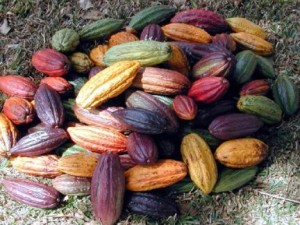
Chocolate. Just typing the word makes me happy (and hungry). We want to eat chocolate. We’re supposed to eat it.
But the world’s cocoa supply is in danger. One reason is that every year about a third of the cocoa crop is destroyed by disease or pests or natural disaster. Who can save the cocoa?
Meet the International Cocoa Quarantine Center in Reading, UK. This center is part of the International Cocoa Germplasm Database (ICGD), which began in 1988 for the purpose of collecting information about all of the cocoa germplasm found in the wild. All cocoa plants being shipped from anywhere must visit the quarantine center to make sure that they are free of disease. This is good news.
However, a recent headline in the Cocoa Barometer reported a more important reason that cocoa is in danger: the number of cocoa farmers is dropping. When you read the story, you’ll see why: the job is hard and low-paying; the current generation of farmers is getting older, and younger people don’t want to do it.
But those aren’t the only reasons. Cocoa-producing countries such as the Ivory Coast engage in human rights violations, including child labor, to maintain the supply of this lucrative commodity. (Most of the workers have never even tasted the final product of what their labor produces; watch these farmers tasting chocolate for the first time.)
Bitter Chocolate: anatomy of an industry, written last year by Carol Off, tells the social history of cocoa farming and exposes the misery caused by working conditions, war, and big business. (This is an e-book; you can look at it right now.) And read about the brutal history of cocoa in Chocolate Islands: cocoa, slavery, and colonial Africa (2012; also an e-book) and Chocolate on Trial: slavery, politics, and the ethics of business.
Noteworthy are the actions of the Cadbury family in the early 1900s, as recounted in Chocolate Islands:
“Cadbury Brothers, the world-renowned chocolatiers, imported more than 50 percent of their chocolate from the Portuguese West African colony São Tomé and Príncipe… at the beginning of the 20th century. When rumors reached William Cadbury in England that these islands were using slave labor to harvest the cocoa, Cadbury sent Joseph Burtt to investigate the labor practices there and then travel onward to Angola, Mozambique, and Transvaal in South Africa from 1905 to 1907. …Burtt concluded that the workers on São Tomé and Príncipe were indeed slaves, and from 1908 to 1909, he and Cadbury traveled to Príncipe, São Tomé, and Angola so Cadbury could observe the situation firsthand. Upon their return, Cadbury and the other British chocolatiers boycotted all further imports.”
